“THE WORST BIKES I EVER RACED” BY JODY WEISEL
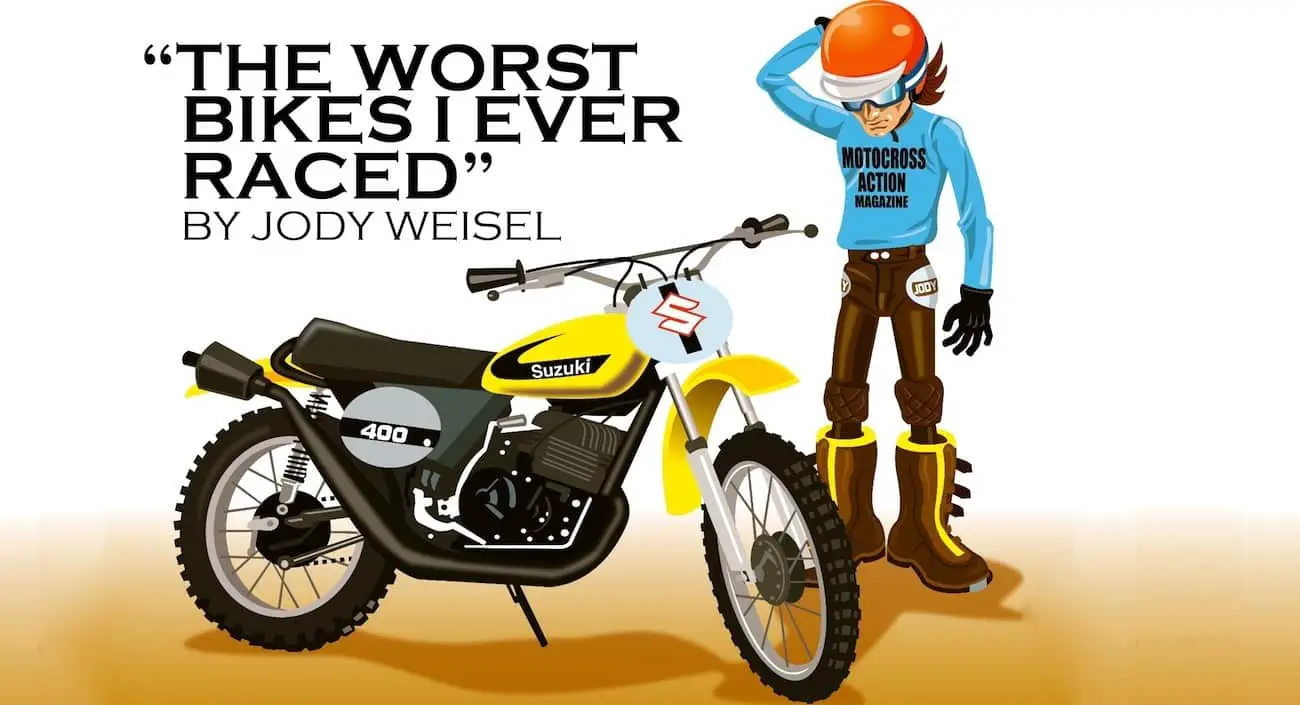 Illustrations by Eduardo Gutierrez Torralba
Illustrations by Eduardo Gutierrez Torralba
I’m not the world’s greatest test rider. And I’m not the worst either, but I am a professional motorcycle test rider, and I’ve been one since before the beginning of time. Or maybe it just seems that way to me. No matter how you cut it, 54 years of motocross racing is a fair bit of time (46 of those years at MXA). Over the course of those years I’ve ridden great bikes, very good bikes, mediocre bikes, bad bikes and bikes that got medieval on my psyche.
Back when I was young, wild and crazy, I took it for granted that the wheels would explode, frames would crack, gas tanks would melt, shock shafts would break, engines would blow up, seats would fly off, radiators would spew and, my favorite, that the footpegs would disappear. Well, they wouldn’t actually disappear; they could still be seen lying in the dirt about 100 feet away from where I crashed. Time has a way of healing all wounds—and improving the breed.
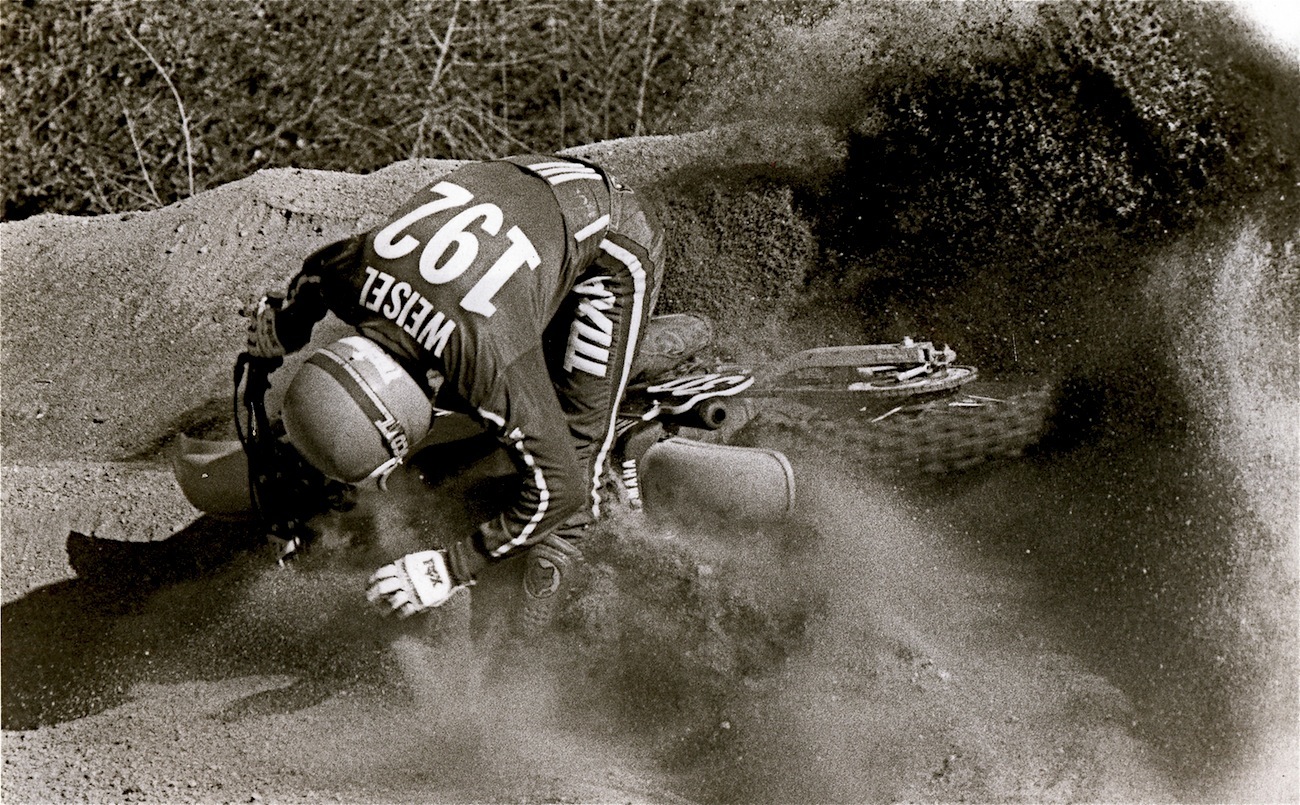 Imagine how many laps, first turns, and crashes this guy has lived through over the last 46 years at MXA. Most of the mystique of being a motorcycle test rider is lost on those who actually do it for a living.
Imagine how many laps, first turns, and crashes this guy has lived through over the last 46 years at MXA. Most of the mystique of being a motorcycle test rider is lost on those who actually do it for a living.
I like to think that I played a small part in the evolution of motocross machines. Today, there are no roaches sold to the public. You might think that I’m happy about that, but I’m not. Oh, don’t get me wrong; I value my well-being enough to be glad not to have to throw a leg over the three C’s (Carabela, Cagiva or Can-Am) ever again, but I miss the thrill of the unknown. Ever since day one I have loved the smell of a new bike—the way the cylinder creaks the first time it reaches maximum temp, the odor of overheated cosmoline, the golden glow of break-in oil and the fumes from burning muffler packing. The tightness that comes with the newness is so ephemeral that you can feel it leave the bike with each foot you ride. I love motorcycles so much that even when I know that a bike is going to be bad, I still want to be the first guy to ride it. The rush is even bigger when a particular bike comes with the cachet of “serial killer with wheels.”
EVEN WHEN I KNOW THAT A BIKE IS GOING TO BE BAD, I STILL WANT TO BE THE FIRST GUY TO RIDE IT. THE RUSH IS EVEN BIGGER WHEN A PARTICULAR BIKE COMES WITH THE CACHET OF “SERIAL KILLER WITH WHEELS.”
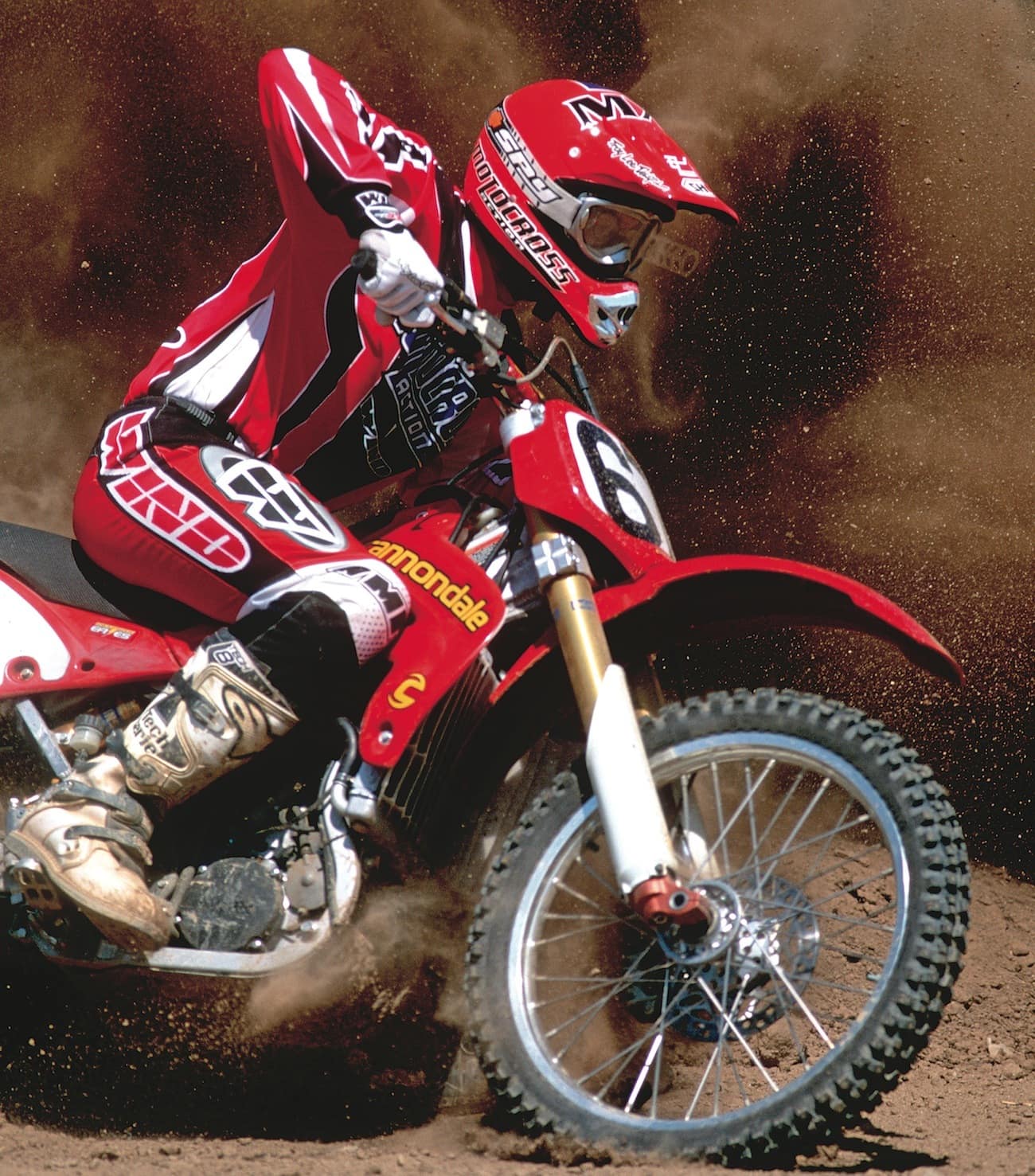 Not every bike makes it through every test. Sometimes the death isn’t mourned, but seen as a reprieve from having to race it ever again.
Not every bike makes it through every test. Sometimes the death isn’t mourned, but seen as a reprieve from having to race it ever again.

When the subject of testing motorcycles comes up, people always want to know what the best bike I ever raced was and what the worst bike was. I’ll keep best bike to myself because I constantly have brand-new models to test and one of them could be the “magic machine.” As for the worst bike, it’s not fair to narrow it down to just one machine, because I’ve raced some horrendous wastes of metal and rubber in my day. It should be said that even the worst bikes have redeeming qualities and the best bikes often have glaring flaws. But a motocross bike is like fine wine: it must be judged by its vintage, not by the standards of today. To a modern rider, all the bikes made in 1978 are the worst bikes made.
To accurately rate the qualities of good and bad bikes, you have to have been around during the year of their vintage. Luckily, I raced old bikes when they were new, and based on those credentials alone, let me hit a few highlights—or would that be lowlights?
THERE IS ONE BIKE THAT SATAN WOULD CHOOSE TO RIDE, IF HE WEREN’T SO BUSY COLLECTING THE SOULS OF WAYWARD YOUTH. IT WAS CALLED THE BLACK WIDOW.
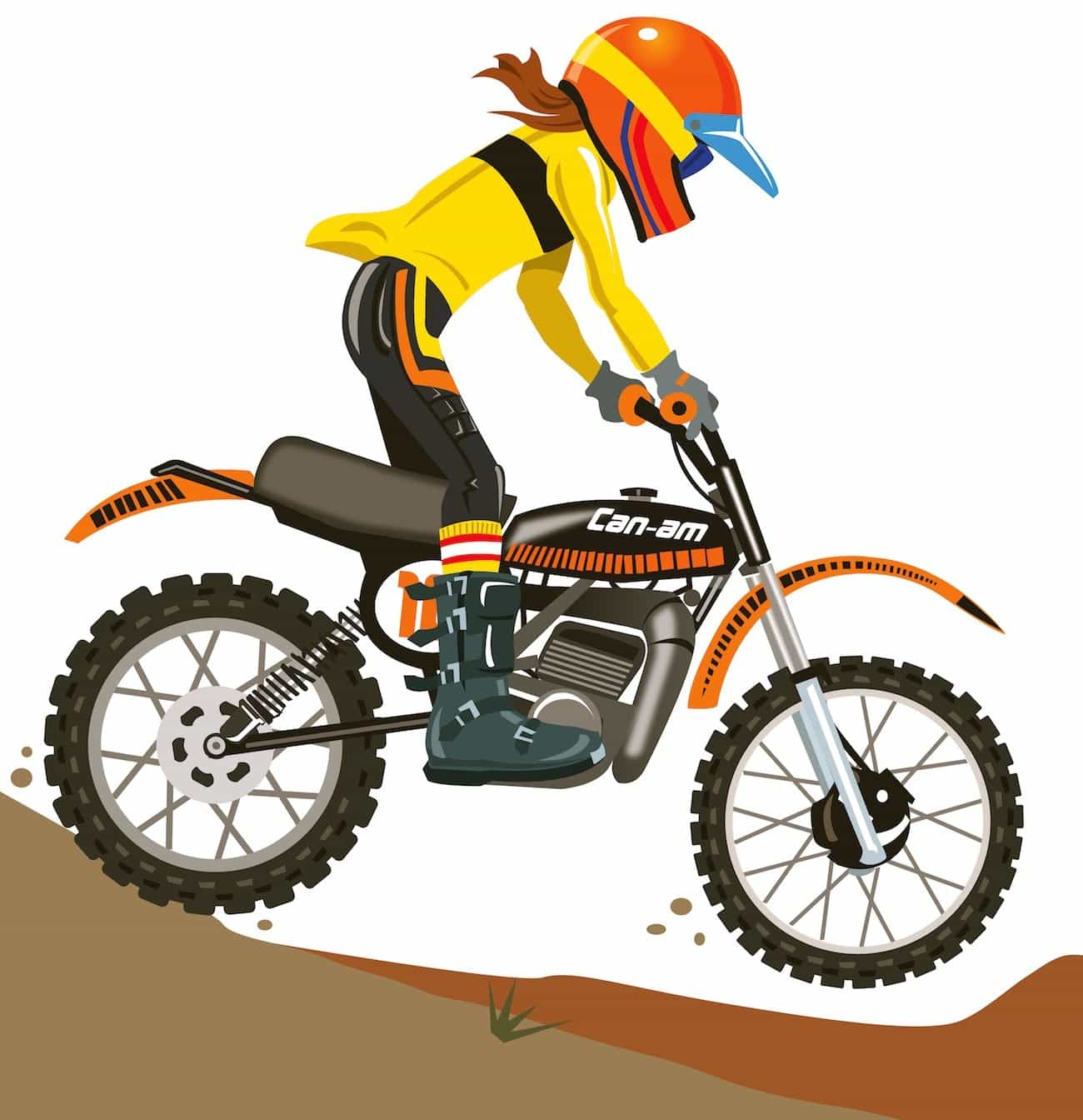 1977 Can-Am MX3: The Black Widow.
1977 Can-Am MX3: The Black Widow.
There is one bike that Satan would choose to ride, if he weren’t so busy collecting the souls of wayward youth. It was called the “Black Widow.” Ever heard of it? First and foremost, no motorcycle company would actually name their bike the “Black Widow” — that would never fly with the marketing department. But worse than an advertising firm giving a bike a flashy but stupid name is when the public crowns a bike with the most negative sobriquet it can come up with. And when Can-Am painted the 1977 MX3 black with orange stripes, you couldn’t help to see the resemblance to the mate-killing spider of the same name.
Not every Can-Am motocross bike was bad, but most were, and the Black Widow was the queen of bad. Back in the day, when people asked how the Can-Am MX3 handled, I always said, “Like the strings on Duane Eddy’s guitar.” It was a 1970s reference, but this was the 1970s. They never asked what that meant, but it left the impression that the bike had a twang, lots of reverb, tons of feedback and an occasional sour note. One time going up Webco Hill at Saddleback Park I had the Can-Am Black Widow singing. The rear tire had a ton of bite against a decent edge going up the hill and, as I crested the top and flicked the bike to make the left-hand downhill turn, I remember thinking, “This bike isn’t that bad. I don’t know what I was worried about.” Then, as I broke traction from the right side of the knobs to the left side, the bike felt as though it had been hit by the gust of a Boeing 747 jet engine. The rear end literally jumped off the ground and passed the front end. I tried to hang on, but I was whipped like a ragged dog against the snow fence…with the front wheel of the Black Widow aimed in the wrong direction. The engine was still purring like a kitten. Bad kitty.
TO ME, CRITICIZING THE 1973 SUZUKI TM400 IS LIKE PICKING LOW-HANGING FRUIT—IT IS TOO EASY. IT IS THE POSTER CHILD FOR THE PHRASE “INJURY FORCES SALE.”
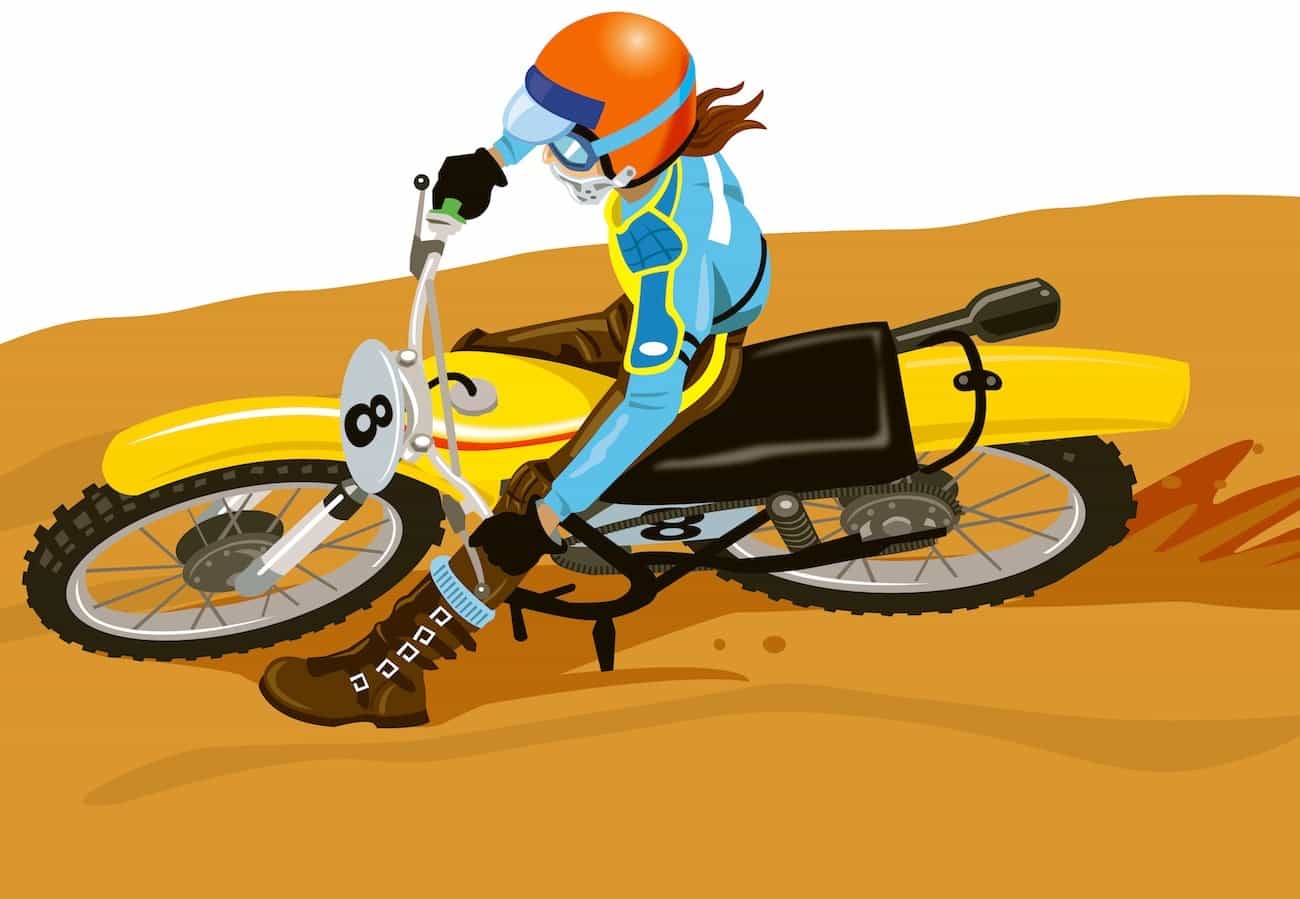 1973 Suzuki TM400: The TM400 is considered the worst motocross bike of all time. Buyers got suckered into buying them because they thought Roger DeCoster raced one.
1973 Suzuki TM400: The TM400 is considered the worst motocross bike of all time. Buyers got suckered into buying them because they thought Roger DeCoster raced one.
To me, criticizing the 1971-74 Suzuki TM400 is like picking low-hanging fruit—it is too easy. It is the poster child for the phrase “injury forces sale.” But just like the wannabes who claim to have been at Woodstock in 1969, just as many people claim to have raced a Suzuki TM400. I know they are lying. How do I know? They aren’t limping enough.
Take it from someone who actually raced the complete series of Suzuki TM400s—it did to 1970s motocross racers what a trebuchet does to a watermelon today. The TM400 Cyclone had a light-switch engine attached to a spaghetti frame. The Cyclone came on so suddenly that it would scare you, and it swapped so bad that it would frighten flagmen on the side of the track. Amusingly enough, I hated the Cyclone most because it was so heavy. How heavy? Well, sadly it weighed 2 pounds less than the 2022 Suzuki RM-Z450. For those brave enough to rap the throttle wide open, three things would happen.
(1) It would smoke the rear tire. The rear tire would light up like a drunken snake on bennies. If you chickened out and rolled the throttle off, the bike would stop spinning the rear tire and hook up, sending you in whatever direction it was aimed, which was never straight ahead.
(2) It would wheelie. Not the graceful wheelie that looked like ballet on one wheel, but a frantic, feet-flying, awkward wheelie. Plus, whenever it wheelied, it always veered toward the biggest and hardest object on the side of the track. If people parked their trucks too close to the track, they often went home with a Cyclone hood ornament. Just as with the spinning rear tire, if you chopped the throttle too quickly, the front end would clang down hard enough to bend the fork tubes out like a chopper. In all my wisdom, I would loosen the triple-clamp bolts and rotate the fork legs 180 degrees so that they were bent back instead of forward. No worries, they would be bent chopper-like again soon enough.
(3) It would scare you. I loved the Suzuki TM125 Challenger and felt that the TM250 Champion was a decent bike, but the TM400 Cyclone was totally unpredictable. I take that back. If you expected bad things to happen, it never disappointed you. Once, at a night race on a ’74 model, I thought someone was trying to pass me on my left side; it turns out that the back of my TM400 was swapping so bad that I could see it in my peripheral vision. Down a rough straight, the TM400 resembled a fish flopping on a beach.
I LOVED MONTESAS—FROM CAPPRAS TO VRs, TO VAs, TO VBs, TO VGs (BECAUSE OF THE VIETNAM WAR THEY SKIPPED VC, AND FOR MODESTY REASONS THEY JUMPED OVER VD).
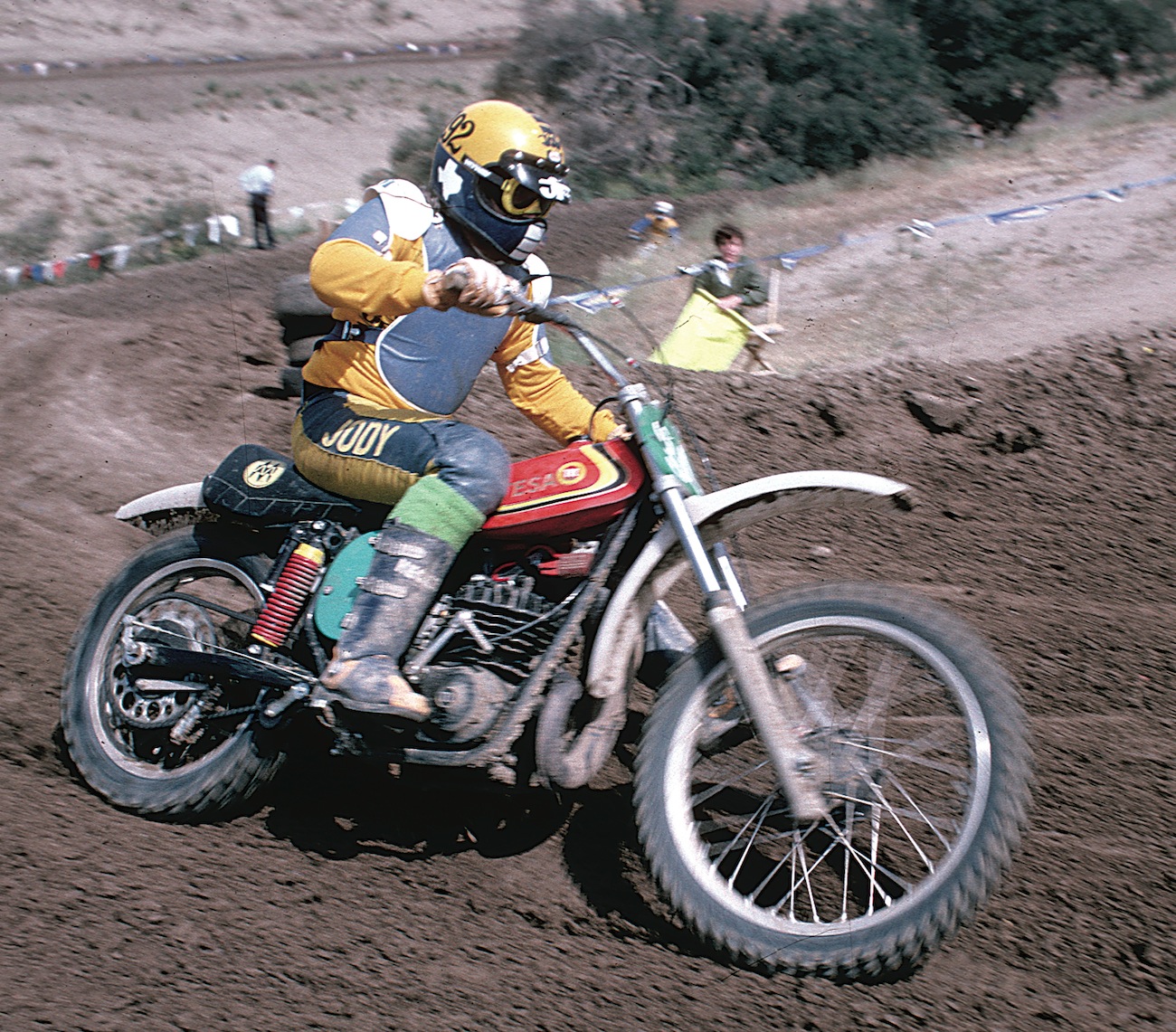 Wrinkle fins. Saddleback Park. Leather pants. Heckel Boots. Skyway goggles. Akront rims. Note that the shock springs are coil bound just from accelerating around this Saddleback corner.
Wrinkle fins. Saddleback Park. Leather pants. Heckel Boots. Skyway goggles. Akront rims. Note that the shock springs are coil bound just from accelerating around this Saddleback corner.
A bike can be bad to all of the people some of the time or some of the people all of the time, but occasionally a bad bike can fool me into thinking it’s good. I loved Montesas—from Cappras to VRs, to VAs, to VBs, to VGs (because of the Vietnam War they skipped VC, and for modesty reasons they jumped over VD). Oh, I knew how bad they were; they wouldn’t turn, the transmission was made of popcorn, the shock spring coil-bound over the starting gate and the rubber parts, most notably the rubber Montesticle fuel petcocks, rotted in the SoCal smog. Yet I was simpatico with the Spanish brand. Viva Montesa!
I WAS CATAPULTED LIKE A CHINESE ACROBAT TRYING TO DEFECT AT MADISON SQUARE GARDEN. I LANDED IN THE CENTER OF THE PITS WITH 275 POUNDS OF RHODE ISLAND-BUILT SNOWBLOWER ON TOP OF ME.
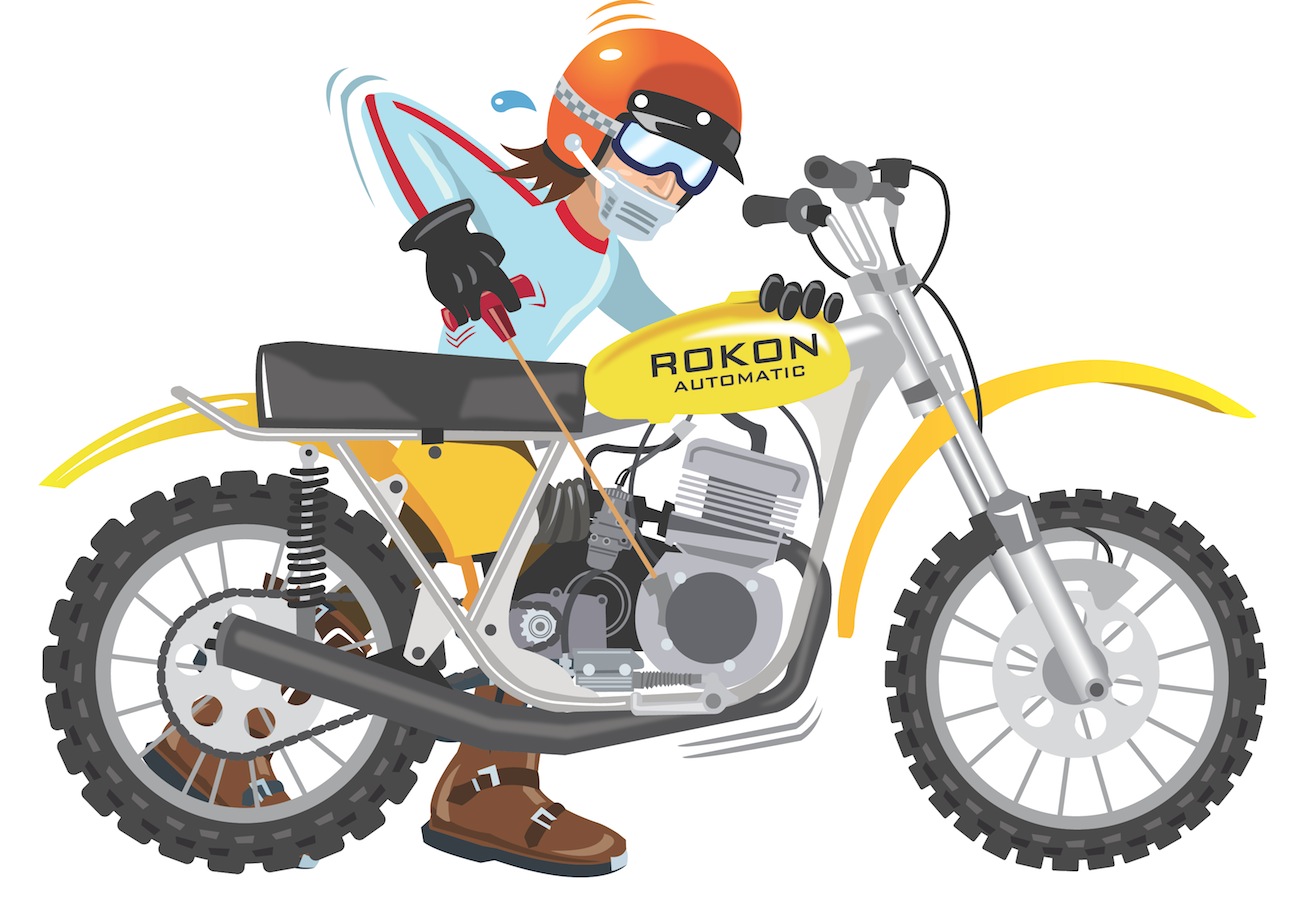 The hard part wasn’t getting the Rokon started with the rope pull, it was what happened after it started.
The hard part wasn’t getting the Rokon started with the rope pull, it was what happened after it started.
Respect and fear are the same thing when it comes to certain machines. When I tested Don Kudalski’s 1975 Rokon 340 Cobra, it was the first time I ever raced with disc brakes (not to mention a Sachs snowmobile engine, Salisbury torque converter and rope pull-starter). I respected the ingenuity of Rokon’s auto-drive. The rider didn’t have to shift, just wick it up and hang on. It seemed so simple. And because it weighed a ton, was wider than a Buick and freewheeled into corners, the Rokon engineers outfitted it with undrilled street-bike disc brakes, front and rear.
On my very first Rokon lap, I rocketed down a long straight and was feeling pretty comfortable, but when I slammed on the brakes for the turn, I was catapulted like a Chinese acrobat trying to defect at Madison Square Garden. The brakes were a far cry from the spongy drum brakes of the day. I landed in the center of the pits with 275 pounds of Rhode Island-built snowblower on top of me. I learned to respect and fear the Rokon—all at the same time.
WHEN PEOPLE ACCUSE ME OF BEING UNFAIR TO A BIKE IN AN MXA TEST, CLAIMING THAT I AM THE REASON THAT THE BIKE FAILED IN THE PUBLIC ARENA, I ALWAYS SAY THE SAME THING: “I DON’T MAKE ’EM, I JUST BREAK ’EM.”
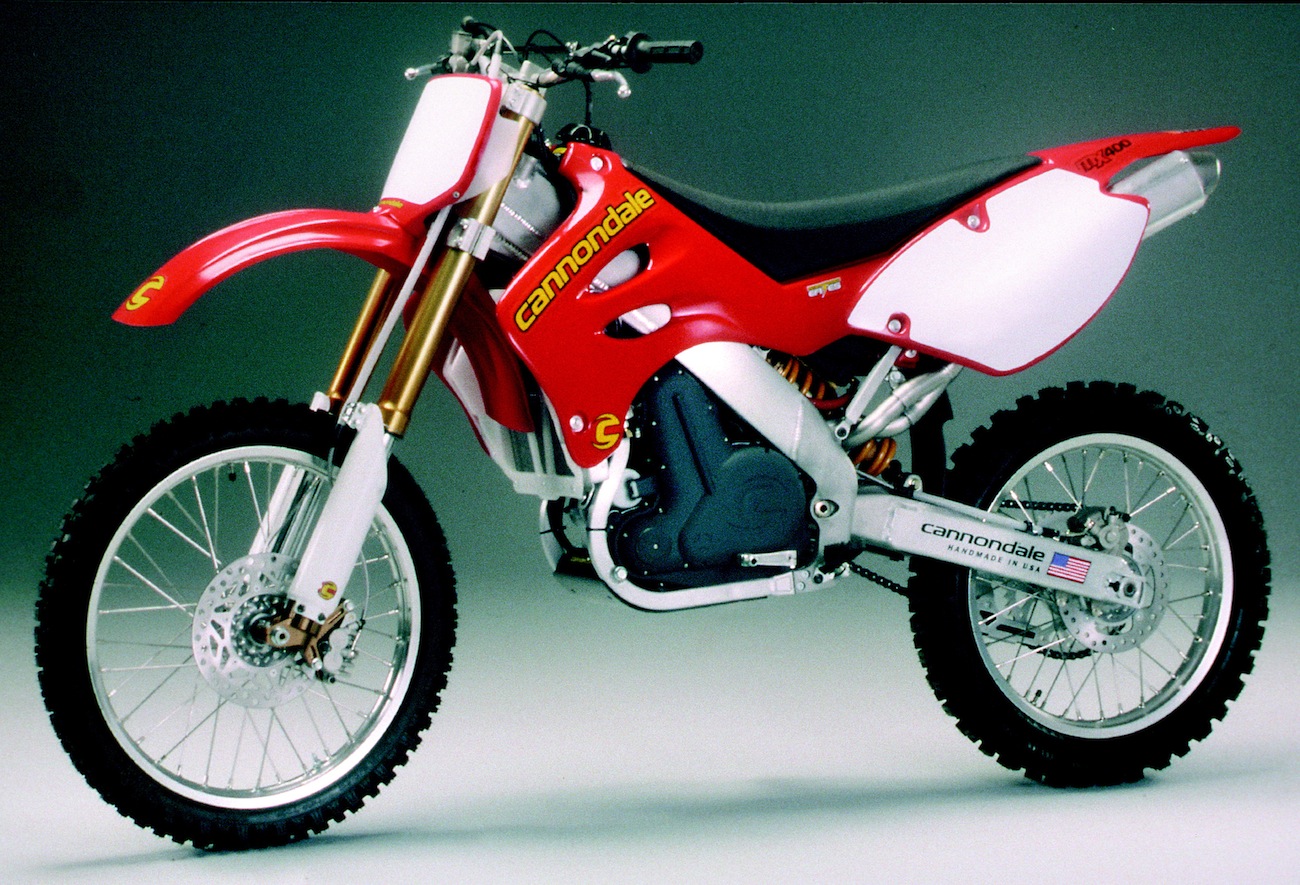 2001 Cannondale MX400: The hype machine built up hopes, but the actual machine crushed them.
2001 Cannondale MX400: The hype machine built up hopes, but the actual machine crushed them.
When people accuse me of being unfair to a bike in an MXA test, claiming that I am the reason that the bike failed in the public arena, I always say the same thing: “I don’t make ’em, I just break ’em.” Which leads me to my 2001 Cannondale MX400 experience. I knew this bike was a roach before it was even made. I was friends with former GP rider Mike Guerra, who was leading the Cannondale project. He stopped by early in the project to tell me Cannondale’s plan. Our conversation could be broken down into my three-word replies to everything he told me. He told me about the copycat 1997 Honda CR250 aluminum frame they were going to use; I said, “That won’t work.” He told me about putting the airbox in the head tube; I said, “That won’t work.” He told me about the laid-down no-link rear shock; I said, “That won’t work.” He told me about the backwards engine; I said, “That won’t work.” Mike thanked me for the input and never spoke to me again. The 2001 Cannondale MX400 was a bad bike; let me list the ways:
(1) The first test bike we got from Cannondale broke in 15 minutes.
(2) For some reason, every time we rode back into the pits, the Cannondale would flame out about 30 feet away from wherever we wanted to go.
(3) The fuel injection was so strange that we could start the bike in the pits, put it in gear and ride around the track without ever touching the throttle.
(4) When the time came to adjust the valves, we had to get a jack out of the back of our truck and use it to lower the engine.
(5) The oil-in-the-frame chassis got so hot that it would blister our skin if we accidentally touched it.
(6) The electric starter worked in the pits, but when you stalled during a moto—and you always stalled during a moto—the battery would run down before the bike would restart.
(7) The suspension was so soft that it clanged like the bell on Big Ben. Even though one magazine called it the “2001 Bike of the Year,” we gave our Cannondale MX400 back to Cannondale after we got tired of pushing it off the track in the middle of every race.
WOULDN’T WE ALL WANT TO OWN A WORKS BIKE? SURE WE WOULD. EVEN IF WE COULD ONLY RIDE IT UP TO 50 PERCENT OF ITS POTENTIAL, THAT STILL MIGHT BE 10 PERCENT BETTER THAN WHAT WE COULD DO ON A STOCK PRODUCTION BIKE.
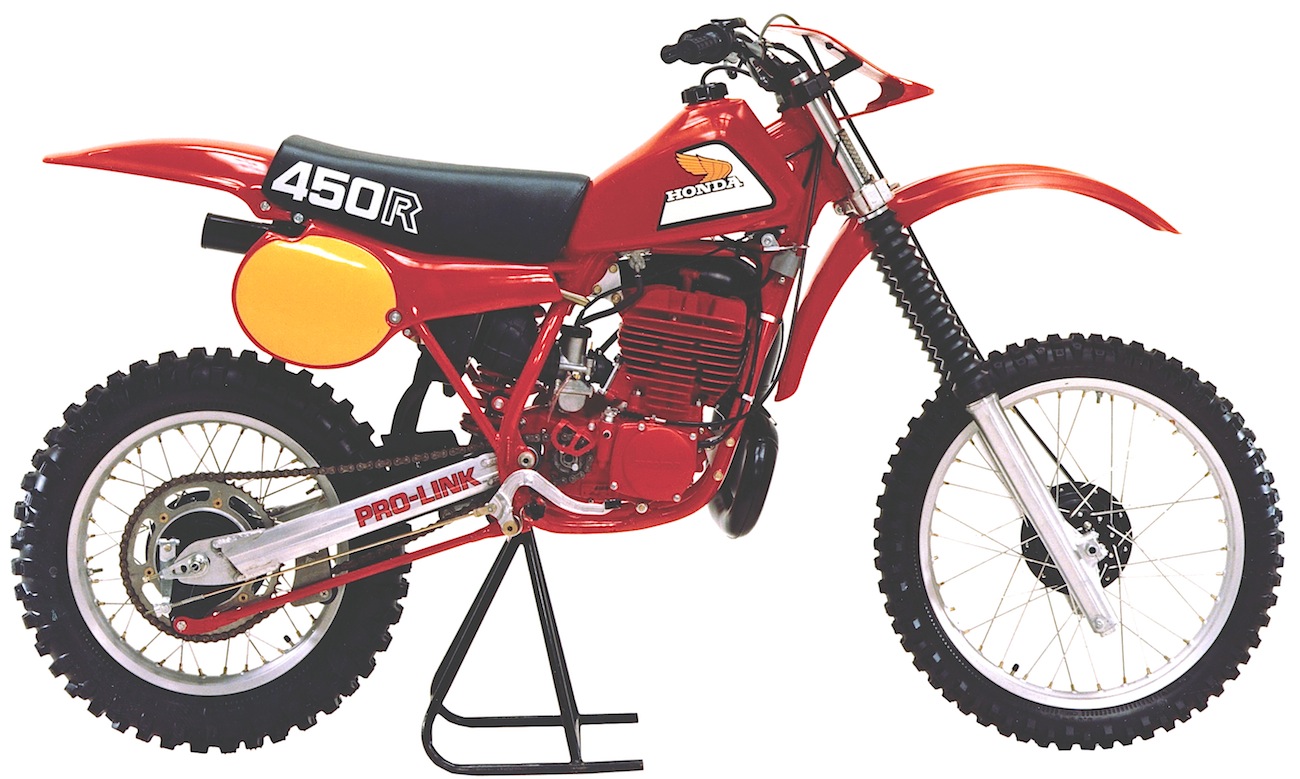 1981 Honda CR450: The public thought that Honda’s first Open bike was a copy of their works bikes. It wasn’t.
1981 Honda CR450: The public thought that Honda’s first Open bike was a copy of their works bikes. It wasn’t.
Wouldn’t we all want to own a works bike? Sure we would. Even if we could only ride it up to 50 percent of its potential, that still might be 10 percent better than what we could do on a stock production bike. So when Honda finally released a production version of the bike that had been winning the 500 National Championship for years, everyone thought that it would be a slam-dunk success. Unfortunately, the 1981 four-speed CR450 two-stroke was a nightmare. The 431cc engine was built on undersized CR250 engine cases. The power was all bottom end, and that was followed by a big bog. The clutch slipped like the Rokon’s torque converter—and when it didn’t slip, it would explode like a dropped ice sculpture at a “Sweet 16” party. The front number plate looked like a snow shovel, the base gasket flew out of the bottom end like shrapnel, and the airbox was so porous that it couldn’t even keep dirt in.
I DIDN’T KNOW THAT THE BIKES I WAS ASSIGNED TO RACE WERE GOING TO BECOME TEMPLES TO THE GOLDEN AGE OF MOTOCROSS. TO ME, IT WAS JUST ANOTHER BIKE AND I DIDN’T HAVE A CRYSTAL BALL.
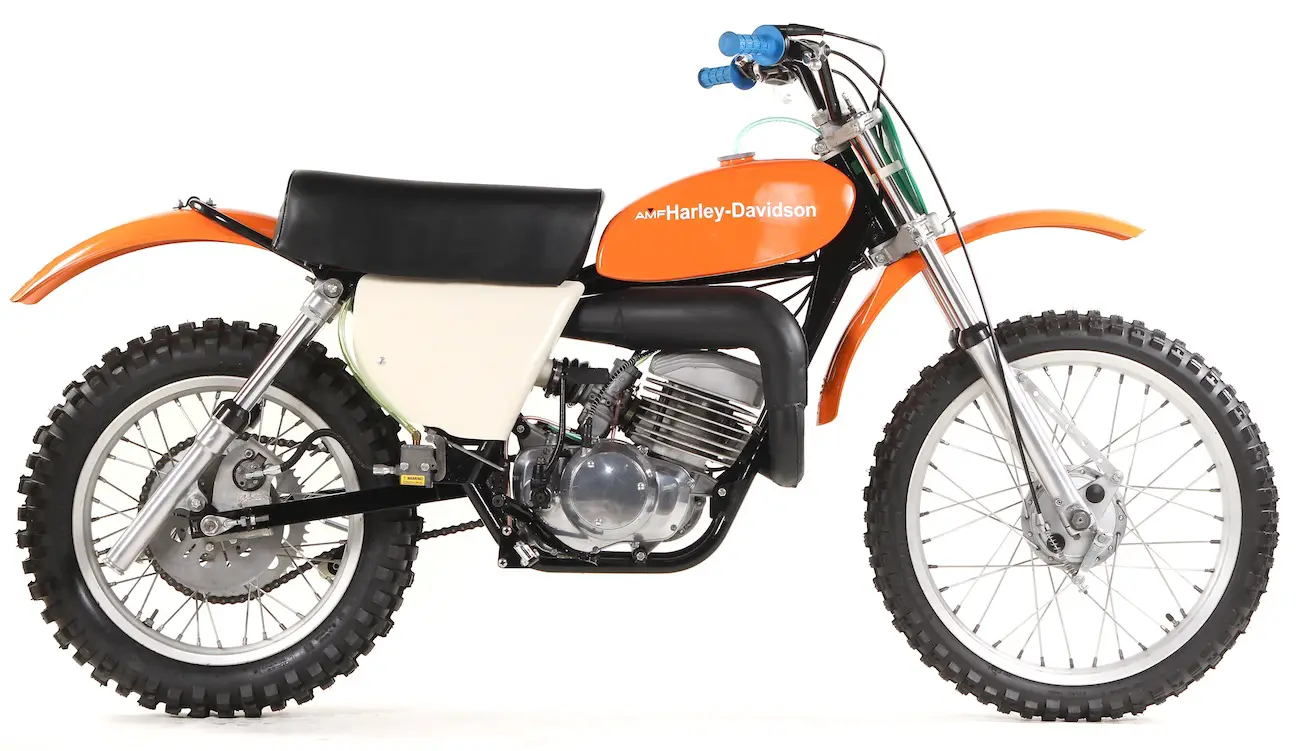 1975 Harley-Davidson 250MX: It may say “Harley” on the tank, but this bike screams in Italiano.
1975 Harley-Davidson 250MX: It may say “Harley” on the tank, but this bike screams in Italiano.
I have raced and tested more different bikes than anyone on the planet. Some of the bikes I got the opportunity to race have gone on to become iconic machines that bike collectors drool over. Sadly, I didn’t know that the bikes I was assigned to race were going to become temples to the golden age of motocross. To me, it was just another bike and another day. I wasn’t blasé about my job; I just didn’t have a crystal ball.
Take the twin-forked 1975 Harley-Davidson 250MX. It was supposed to be a production bike, but only 65 were ever made. Nobody told me that it was going to be rare when I threw a leg over it (although by the time I threw a leg back off it, I knew it wasn’t going to sell). The only thing I knew was that in the archaic suspension days of the 1970s, some confused Harley engineer (at the Aermacchi factory in Varese, Italy) put a set of forks on the rear of the Harley for the fallacious reason that riders always complained about their rear shocks, but they rarely complained about their forks. The fly in the ointment is that forks only have to hit bumps, while the shock has to handle the bumps, plus the chain torque of the engine. I didn’t like the Italian-built engine, the frame geometry, the rear disc brake (I put a Yamaha drum brake on my test bike), the ergos or the fitment, but the rear forks actually worked pretty well.
Once in the ’70s, at the Lockhart track in Texas (a track that we called “Rockhart” for reasons that became all too obvious as soon as you got roosted), I raced a Hodaka in the 100 class, Bultaco Pursang in the 250 class and BSA 441 Victim (Victor) in the 500 class. The BSA shifted on the right, and all three bikes had completely different shift patterns (some up for low and some down). You haven’t lived until you go for the brakes only to hit the shifter and vice versa. I was never as happy as the day that the NHTSA passed a law that said all bikes had to shift on the left and go down for low.
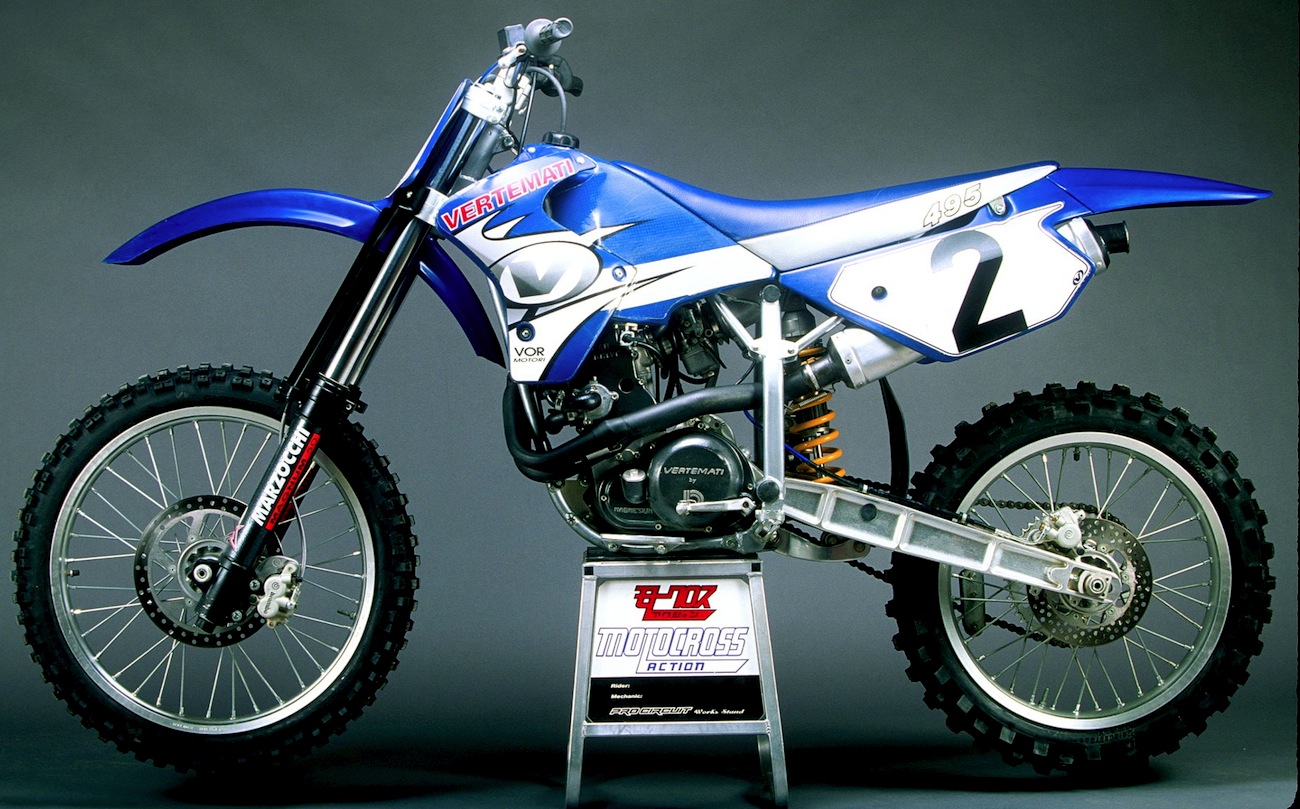 Note the billet swingarm – very stiff. Note the bolt together frame – very flexy. If an MXA test rider was very bad – this was the bike he would be assigned to race. He would be good after that
Note the billet swingarm – very stiff. Note the bolt together frame – very flexy. If an MXA test rider was very bad – this was the bike he would be assigned to race. He would be good after that
In 1999, MXA got its hands on the rarest of all motocross bikes—the fabled Vertemati four-stroke. Because of their rarity, these GP bikes had a reputation for being the best bikes ever built. Since only a handful were ever made, and no one outside of the honored few ever got to ride them, they were the holy grail of motocross bikes. In truth, the fabled Vertemati and its VOR V495 brother were ill-handling boomerangs that oozed trickness as long as they were sitting still. Once in motion, they were a handful. The front end understeered like a snowplow, the rear suspension was more jackhammer than shock absorber, and the vaunted, hand-built, four-stroke, V495 engine was equipped with a three-speed tranny (that had neutral on the bottom). You had to pretend that you were Clint Eastwood when you raced the bike to avoid hitting neutral in the middle of a race. “You have to ask yourself, did I downshift once or did I downshift twice. Well, did I, punk?” If you guessed wrong, you got pitched over the bars.
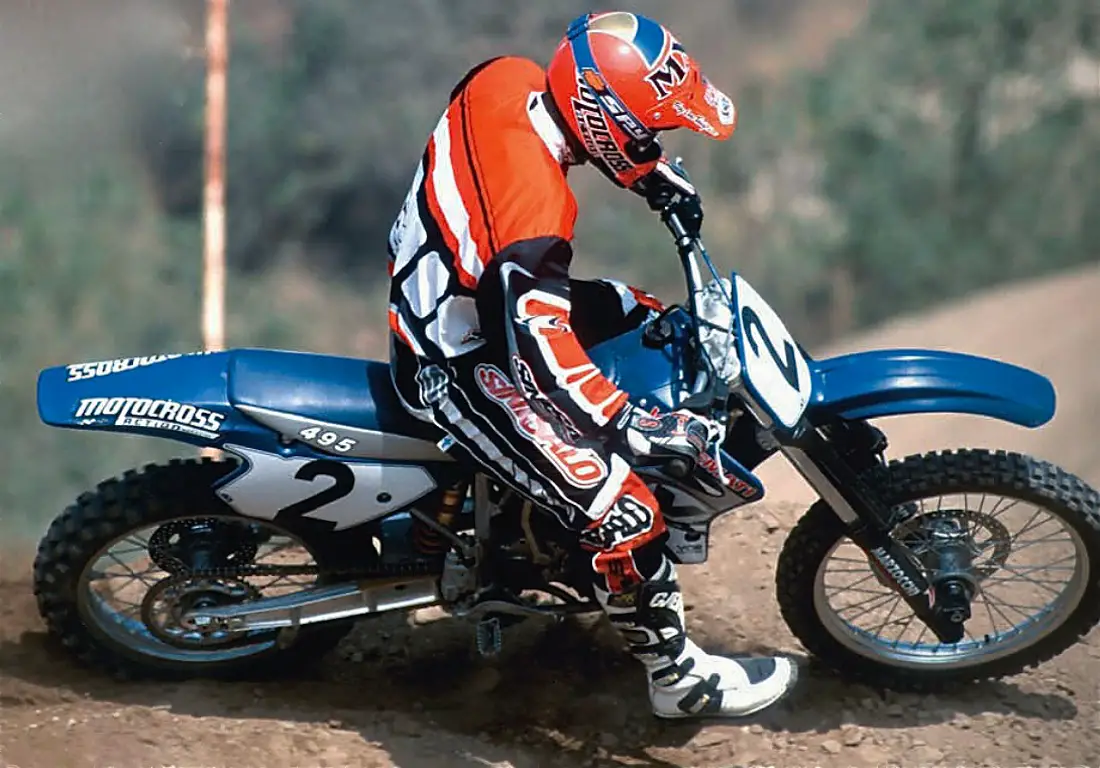
1999 V495 Vertemati, also imported to the U.S.A. as a VOR, it had a great reputation with everyone who never had to race one.
PLENTY OF MODERN BIKES ARE BAD, MAYBE NOT AS BAD AS THE BLACK WIDOW, BUT ANY FLAW AFTER 50 YEARS
IS MORE EGREGIOUS THAN THE MISTAKES OF THE CHILDHOOD YEARS OF THE SPORT.
It may seem as though all of the bad bikes were made 20 or 30 years ago, but that isn’t true. They just have had a longer time for their legend to grow. Plenty of modern bikes are bad, maybe not as bad as the Black Widow or the TM400, but any flaw after 50 years of intense development is more egregious than the mistakes of misguided engineers back in the childhood years of the sport.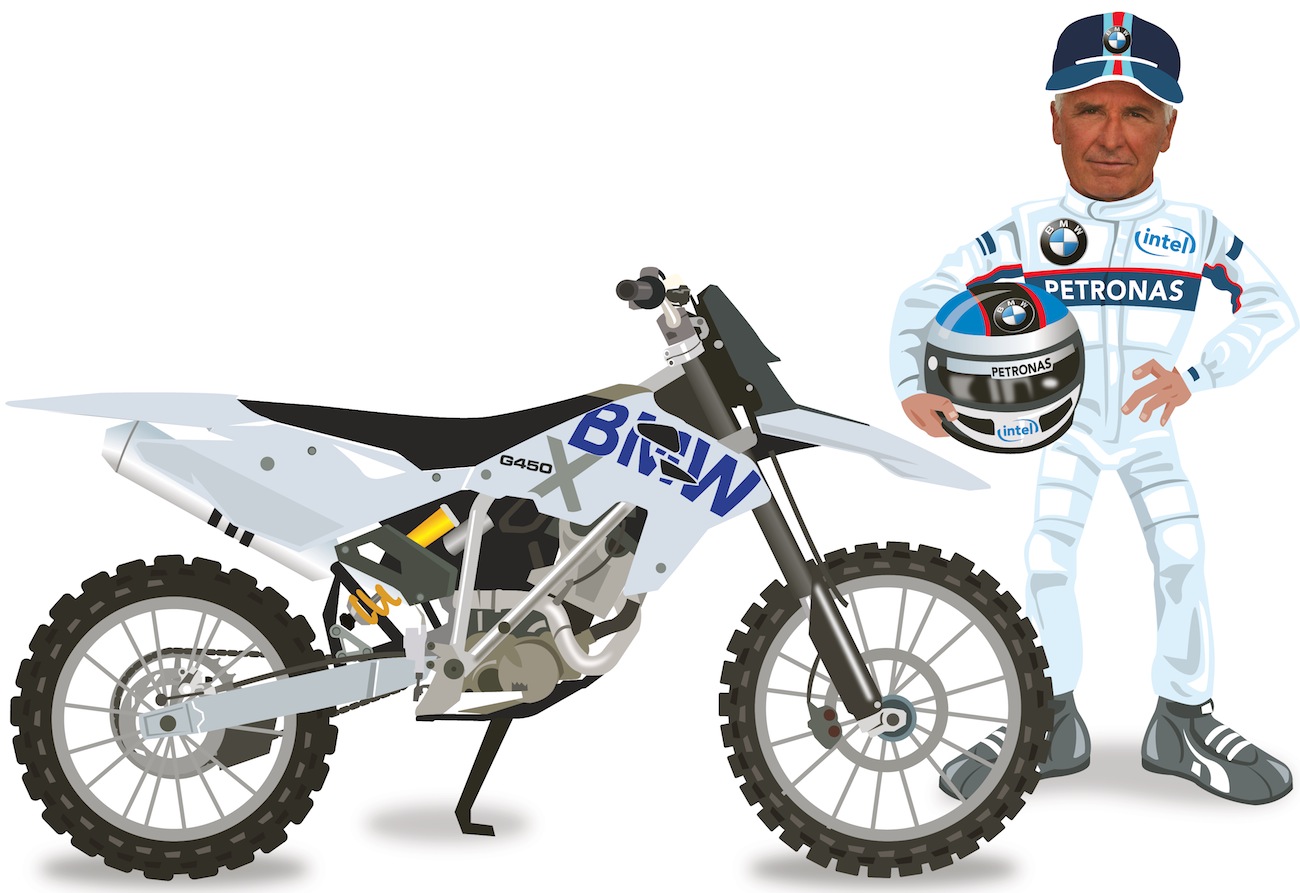
A couple years ago I was hanging out at the track with the MXA gang when the Dirt Bike guys asked me if I’d like to ride the then-new BMW G450X. Although it wasn’t a motocross bike and I had no plans to ever test it for MXA, I was still intrigued to throw a leg over this uniquely different machine — just to try it out and not to test it. It had a radically canted Taiwanese engine, a strange hanger-style frame and a swingarm pivot that was aligned with the countershaft sprocket. I’d learned long ago that creativity for creativity’s sake is never a good idea. I snicked the G450X into gear and roared off down the trail as the Dirt Bike guys turned and walked back to their truck, which was about 50 feet away. They were shocked when I showed up at their truck before they did. I climbed off of the BMW G450X, handed it back to them and said, “Thanks, but no thanks.”
“What’s wrong?” they asked.
“Everything,” I replied.
“But you couldn’t have ridden it more than 100 feet.”
“Actually, I rode it 200 feet. One hundred feet out and 100 feet back. I don’t need to ride it any farther. I’ve never ridden a bike that was so wrong, in so many ways, in such a short distance. Thanks anyway.”
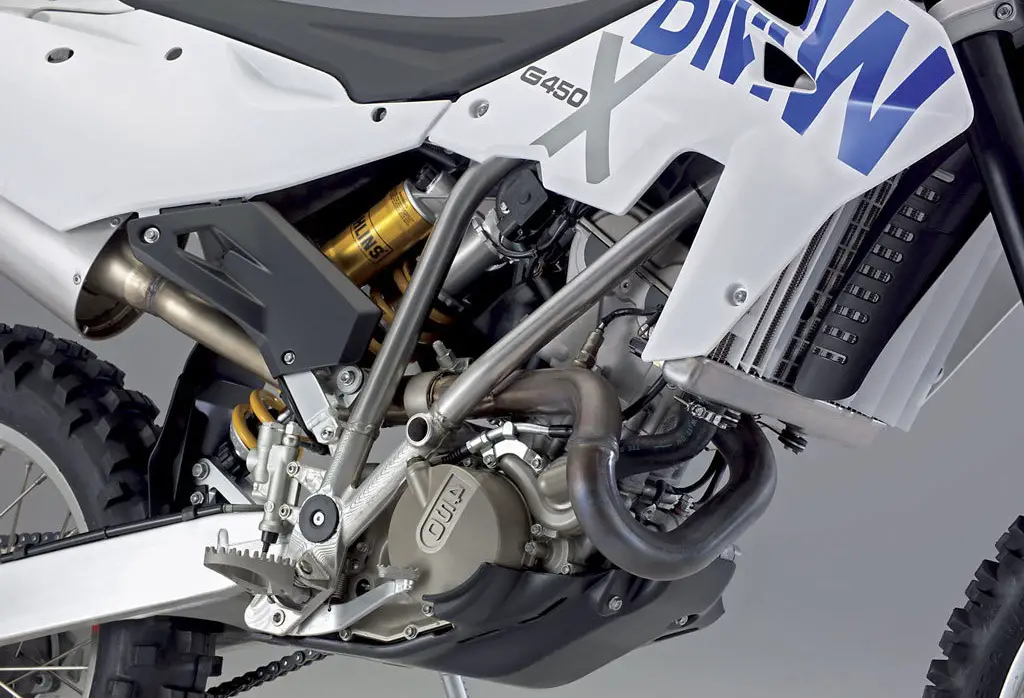 BMW’s answer to questions that no one asked.
BMW’s answer to questions that no one asked.
I could afford to be cavalier about the BMW G450X, because it wasn’t designed as a motocross bike, and I was pretty sure that I would never see it again. At least I hoped not. I was wrong. Two years later, Husqvarna released the 2011 Husqvarna TC449 motocross bike. It was a mildly disguised G450X. On the plus side, Husky’s engineers had put some development time into the old BMW design, which had since failed. But because Husky belonged to BMW then, the corporate heads wanted to get some of their investment back by making Husqvarna sell the warmed-over G450X.
THE 2011 HUSQVARNA TC449 WAS A BIKE THAT LOOKED LIKE IT WAS DESIGNED BY A COMMITTEE THAT NEVER MET.
The 2011 Husqvarna TC449 was a bike that looked like it was designed by a committee that never met. The gas cap was in the back of the seat. The clutch was mounted on the crankshaft. There were two gas tanks, and it still didn’t hold 2 gallons of gas. The front fender had 11 different parts. The air filter was where the gas tank used to be, but still required two different-size wrenches to get to. There were two ignition maps—we labeled them “bad” and “really bad.” The shock linkage was mounted on top of the swingarm, which limited the stroke of the shock shaft. The side panels looked like pontoons. The clutch cover stuck out so far that your boot hit it while braking. The TC449 was slow, revved even slower and handled like a wet sponge. I talked to the Husky guys almost every day during the test period, and I don’t think that I ever let my tone give them a clue about how wrong the testing was going. But, I must have tipped my hand, because just as we finished the test period, Husky called and said that they had decided not to import any of the motocross versions of the TC449 to the United States. When I returned the 2011 TC449, I suggested that they never import this particular bike—ever.
TRULY ATROCIOUS BIKES ARE LIKE ROAD TRIPS GONE BAD—THEY GIVE YOU A LIFETIME OF FUNNY TALES TO TELL.
BUT BIKES THAT AREN’T ATROCIOUS, JUST FLAWED, DON’T HAVE ANY LITERARY VALUE.
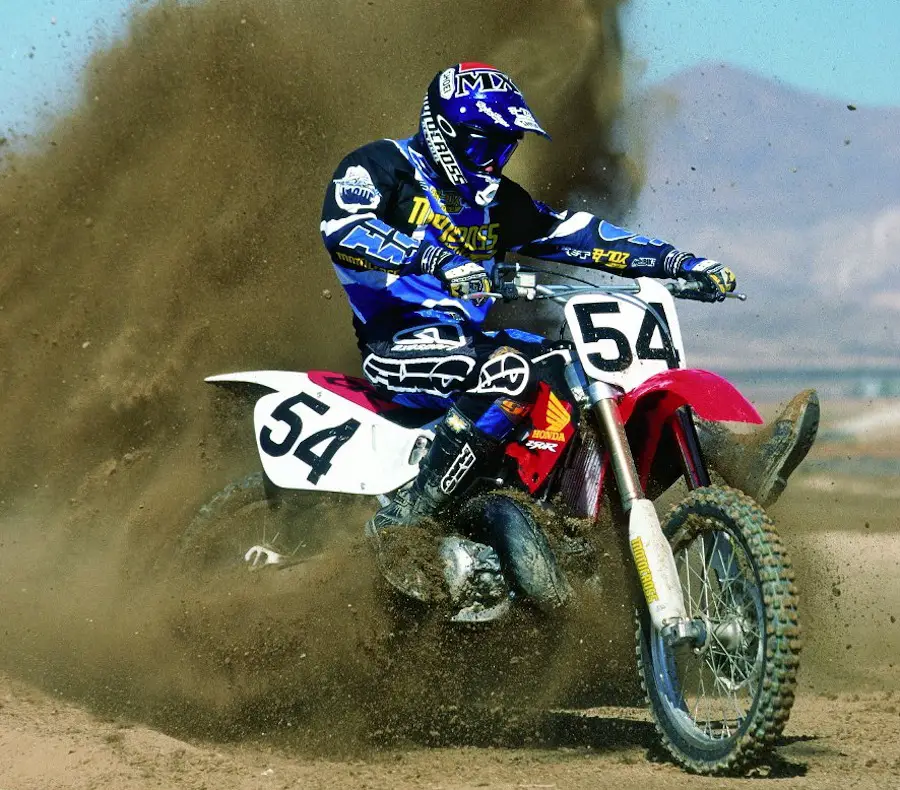
1997 Honda CR250: Stiff doesn’t describe it.
Truly atrocious bikes are like road trips gone bad—they give you a lifetime of funny tales to tell. But bikes that aren’t atrocious, just flawed, don’t have any literary value. Take the 1997 Honda CR250. It was the first modern bike with a Delta-Box aluminum frame. It should have alerted us to the fact that aluminum frames may be cheaper for the manufacturers to make, but they don’t have the resilience of chromoly steel. Now, 20 years later, the engineers are still trying to find a way to make a forgiving aluminum frame; meanwhile, KTM just stuck with steel.
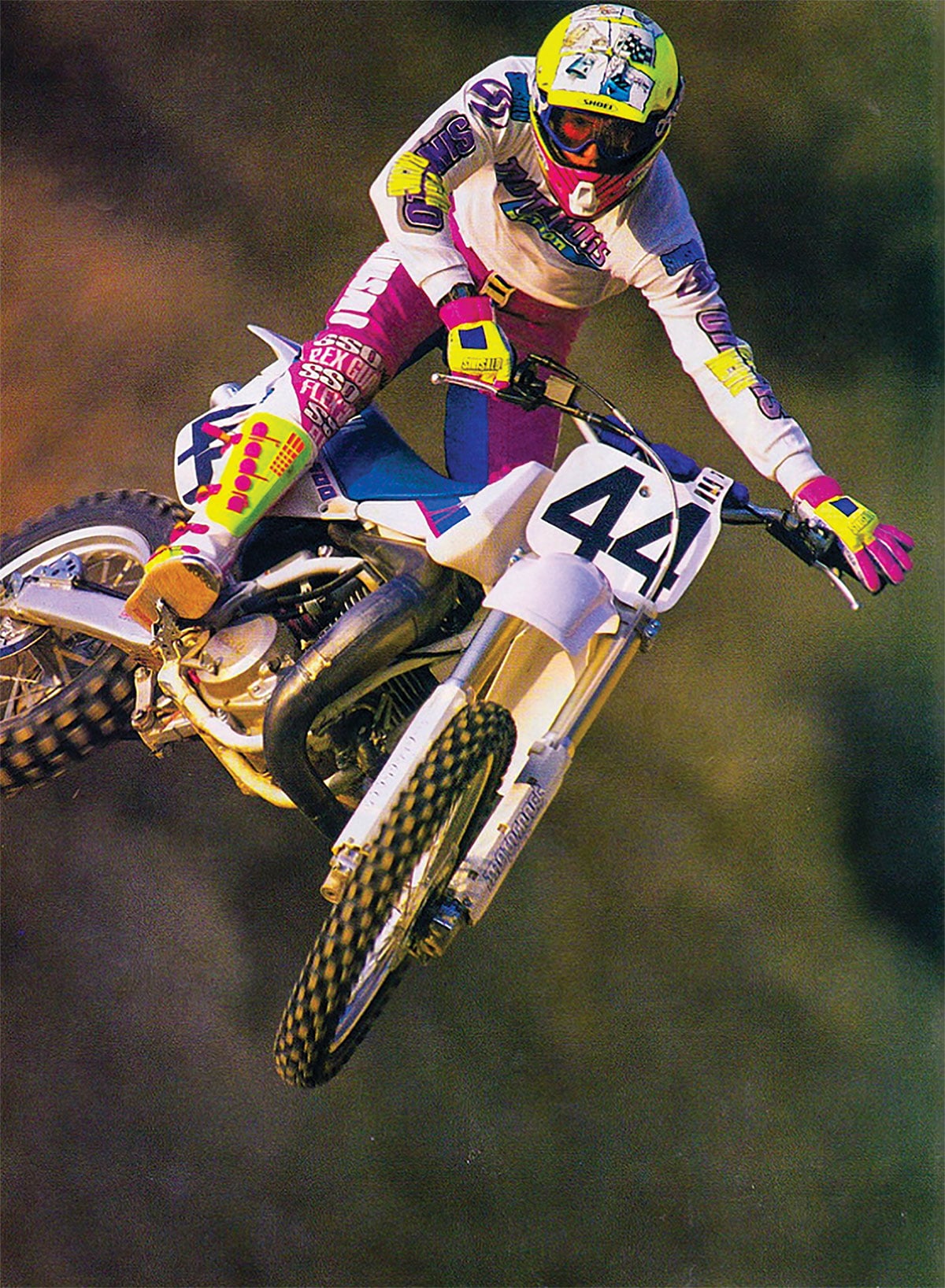 Yes, the tank on the Yamaha WR500 was that wide.
Yes, the tank on the Yamaha WR500 was that wide.
Do you remember when Yamaha built the WR500? The year was 1991 and Yamaha’s engineers played “Supermarket Sweepstakes” in the parts department to build a Frankenstein bike that combined a YZ250 frame with an air-cooled YZ490 engine. The result was a bike that we called the “Maytag” because it vibrated like a runaway washing machine.
THE BEST HOP-UP STRATEGY FOR A 2007 KAWASAKI KX250 WAS TO HOP IT DOWN. THE HANDLING
WASN’T ANY BETTER. THE 2007 KX250 WAS A TURN-AND-STOMP CHASSIS.
In 2006, Kawasaki dropped the KX125 two-stroke from the American market, but kept the KX250 for 2007. We had to wonder why. It had an almost useless powerband that was highlighted by an explosive hit that shredded knobs. The best hop-up strategy for a 2007 Kawasaki KX250 was to hop it down. The handling wasn’t any better. The 2007 KX250 had a “turn-and-stomp” chassis. What is that? When the KX250 turned, the front end stepped out so fast that you had to stomp your boot on the ground to drag it back in.
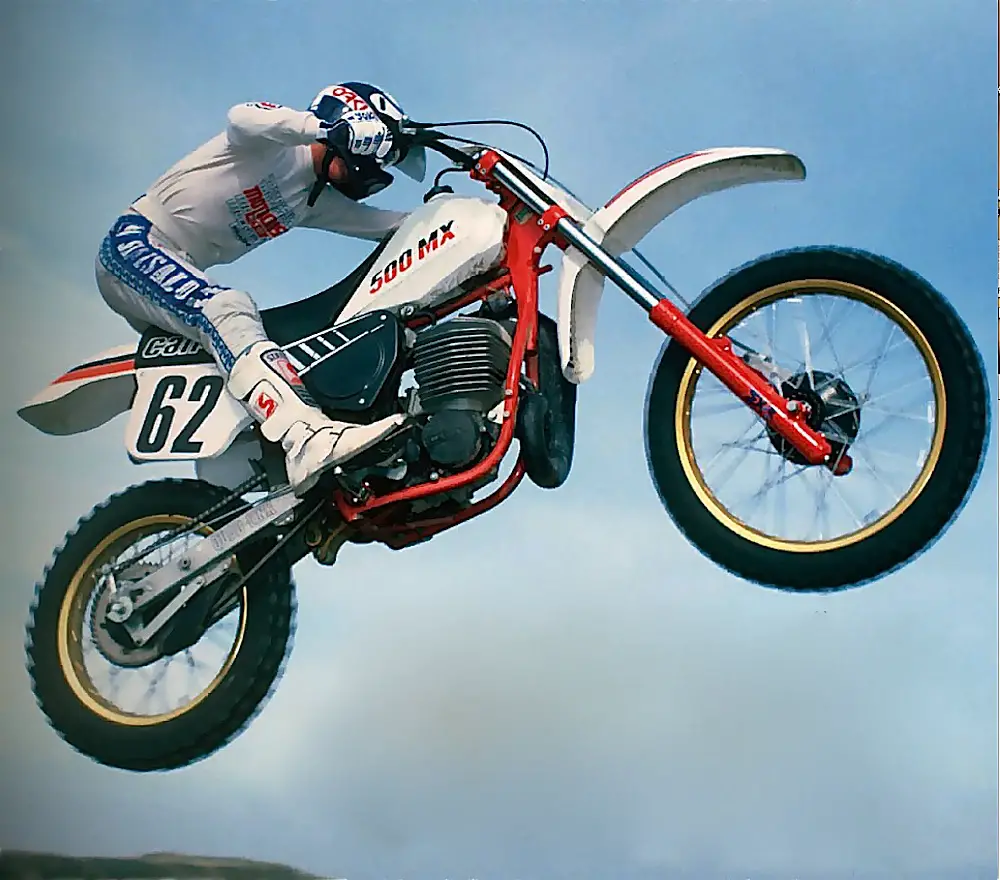 Test riders don’t get to choose the bikes they race. You ride what you are assigned – even if you’re not sure what it is. This is a 1983 air-cooled Can-Am 500MX Sonic. It was built by the British Armstrong company when Bombardier decided to quit building their own motocross bikes. It was atrocious.
Test riders don’t get to choose the bikes they race. You ride what you are assigned – even if you’re not sure what it is. This is a 1983 air-cooled Can-Am 500MX Sonic. It was built by the British Armstrong company when Bombardier decided to quit building their own motocross bikes. It was atrocious.
When I came to Motocross Action back in 1976 I had already been testing bikes and products for a couple years. There were times during my testing career when I thought I knew everything. I didn’t… as the next bike on my test schedule would soon prove. I learned little by little, mistake by mistake and bike by bike. And over those decades I came to realize that the measure of a test rider isn’t defined by the coolness factor of being the first to ride a new bike, nor the fact that so few people are chosen to do the job. It is measured by his willingness to ride whatever he is assigned, follow through on all the test protocol and try to find the best possible setup for the consumer. In many ways test riders are just worker ants—doing a job, and, for the greater part, it is not a very adventurous job.
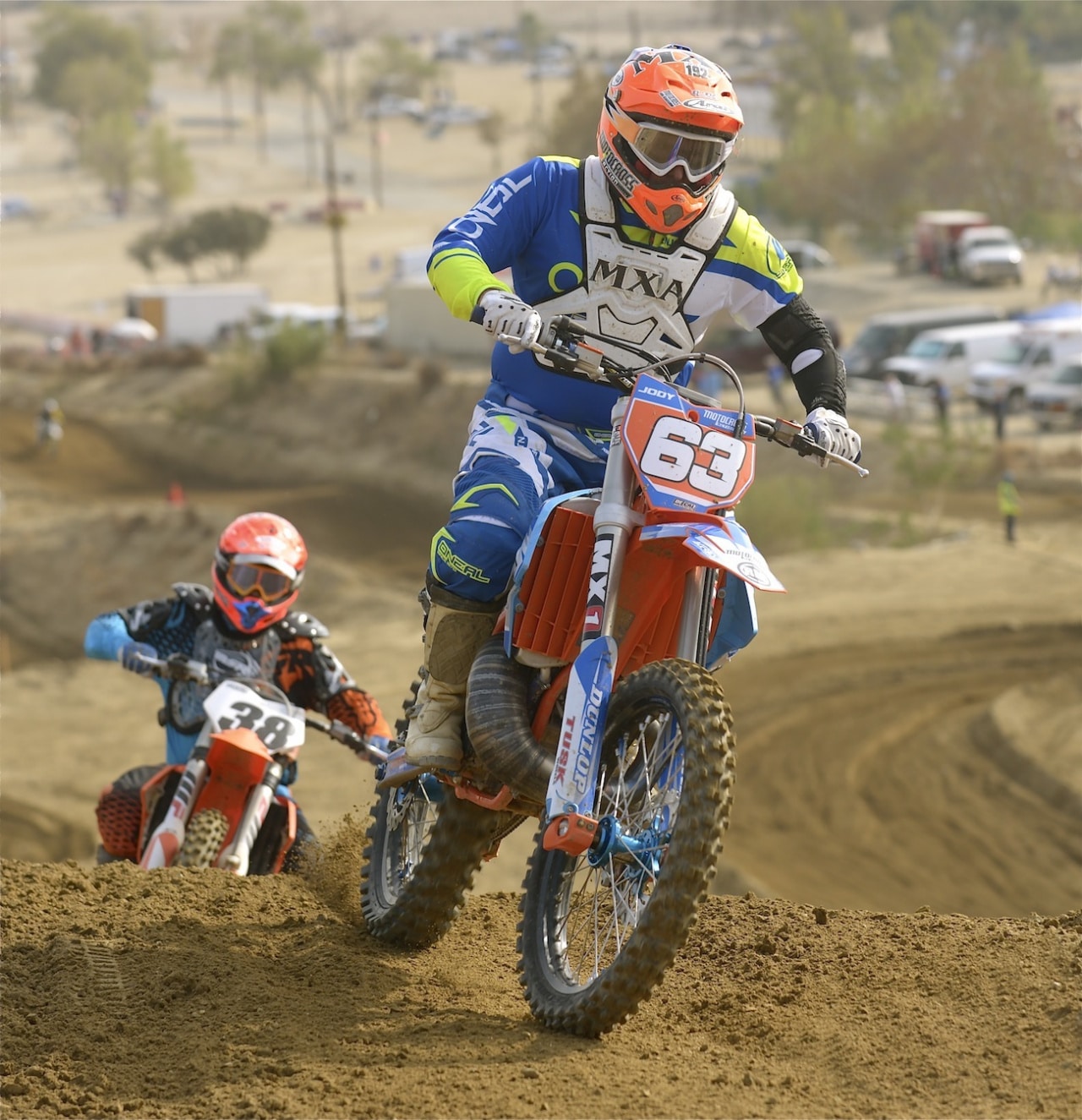 Considerably older and considerably slower than when he was CMC Number One back in the day, Jody has raced every motocross bike made since 1973. This is Jody on a fuel-injected KTM 300XC-W TPI two-stroke at Glen Helen.
Considerably older and considerably slower than when he was CMC Number One back in the day, Jody has raced every motocross bike made since 1973. This is Jody on a fuel-injected KTM 300XC-W TPI two-stroke at Glen Helen.
I believe that every man who races a motorcycle is a test rider. Why? Because you have it in your power to make your motorcycle better or worse. Every decision you make, even the smallest ones, affects the way your personal bike performs. With enough experience and enough laps, every rider can analyze the pluses and minuses of his own bike.
As a guy who has made his living evaluating race bikes, you might think that I would be the prime benefactor of the overall improvement in the breed over the decades. Not so. Why not? There is job security in mediocrity. So, when I see an incredibly creative new motorcycle design, I don’t imagine the world’s greatest bike; instead, visions of Cannondale, Can-Am and Carabela dance like sugarplums in my head.


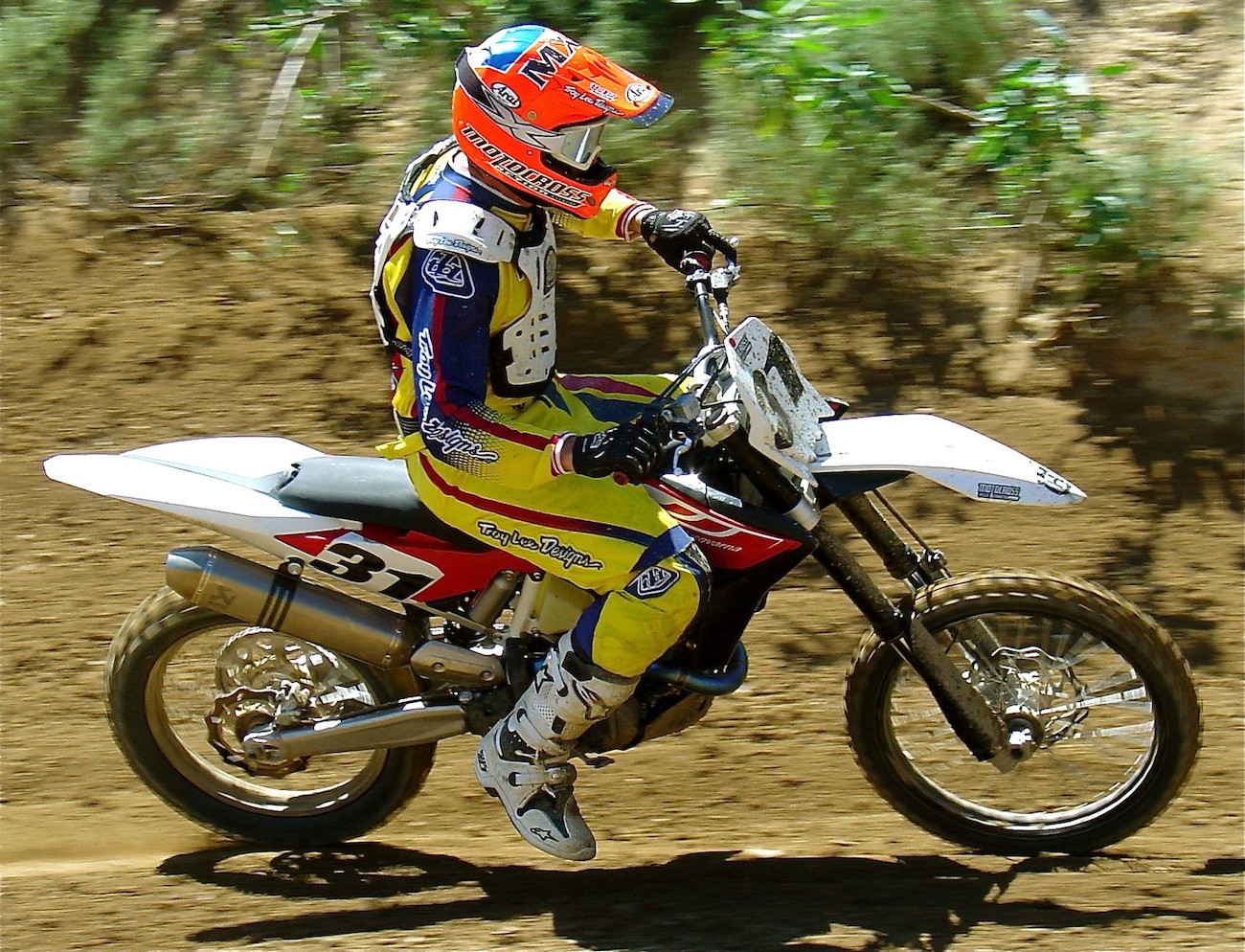
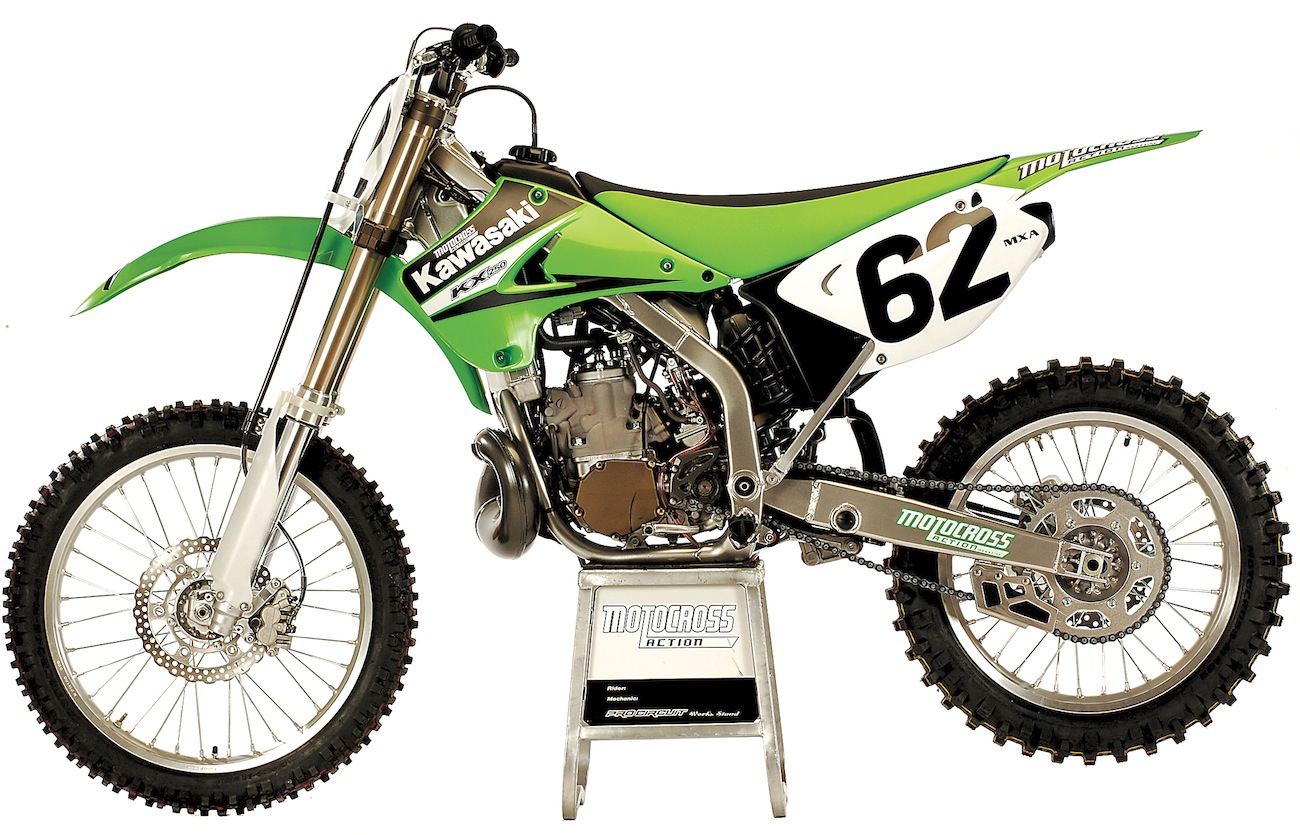




Comments are closed.